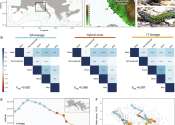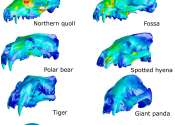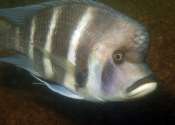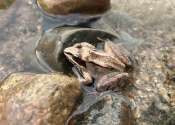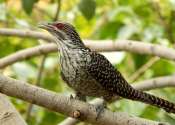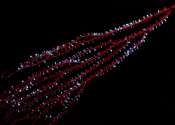Last update:
Evolution news
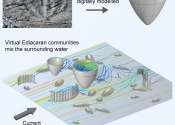
Study indicates Earth's earliest sea creatures drove evolution by stirring the water
A study involving the University of Cambridge has used virtual recreations of the earliest animal ecosystems, known as marine animal forests, to demonstrate the part they played in the evolution of our planet.
Evolution
3 hours ago
0
22
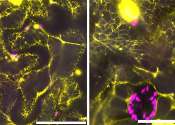
Modern plant enzyme partners with surprisingly ancient protein
Scientists from the U.S. Department of Energy's (DOE) Brookhaven National Laboratory have discovered that a protein responsible for the synthesis of a key plant material evolved much earlier than suspected. The research published ...
Evolution
5 hours ago
0
4

A new 'rule of biology' may have come to light, expanding insight into evolution and aging
A molecular biologist at the USC Dornsife College of Letters, Arts and Sciences may have found a new "rule of biology."
Evolution
5 hours ago
0
21
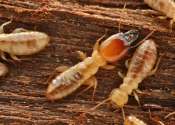
Genetic analyses show how symbiotic bacteria in termite gut has changed over course of evolution
Researchers at the Max Planck Institute for Terrestrial Microbiology in Marburg, Germany, have analyzed the evolutionary development of symbiotic bacteria in the intestines of termites with regard to their metabolic capabilities.
Evolution
23 hours ago
1
5
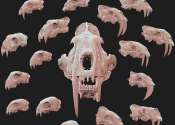
How saber-toothed tigers acquired their long upper canine teeth
An international team led by scientists from the University of Liège has investigated the evolutionary patterns behind the development of saber teeth, with some unexpected results along the way. Their study has been published ...
Evolution
May 16, 2024
0
121

Unwrapping the origin story of the baobab
The baobab (Adansonia) is a genus of trees with eight currently extant species and a long history of humans marveling at them. For as much admiration as the baobabs get, there is an equal amount of mystery surrounding their ...
Evolution
May 15, 2024
0
13
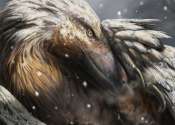
First 'warm-blooded' dinosaurs may have emerged 180 million years ago
The ability to regulate body temperature, a trait all mammals and birds have today, may have evolved among some dinosaurs early in the Jurassic period about 180 million years ago, suggests a new study led by UCL and University ...
Evolution
May 15, 2024
0
97

New candidate genes for human male infertility found by analyzing gorillas' unusual reproductive system
Despite their formidable bodies, male gorillas are lacking in one particular area of their anatomy.
Evolution
May 14, 2024
0
224

Discovery of the first ancestors of scorpions, spiders and horseshoe crabs
Who were the earliest ancestors of scorpions, spiders and horseshoe crabs? A Ph.D. student from the University of Lausanne (Switzerland), with the support of a CNRS researcher, has identified a fossil that fills the gap between ...
Evolution
May 14, 2024
0
139

Study supports theory that humans evolved the ability to run long distances to capture prey
A pair of anthropologists, one with Trent University, in Canada, the other with the University of California, Davis, in the U.S., reports evidence in support of a theory that humans developed the ability to run long distances ...

Evolutionary history shapes variation of wood density: Study
Ecology and evolutionary biology suggest that closely related species are more likely to exhibit morphological and functional similarities compared to distantly related species. Each tree species represents a unique genetic ...
Evolution
May 13, 2024
0
19

Study reveals insights into protein evolution
Rice University's Peter Wolynes and his research team have unveiled a breakthrough in understanding how specific genetic sequences, known as pseudogenes, evolve. Their paper was published May 13 in the Proceedings of the ...
Evolution
May 13, 2024
0
119

Island birds more adaptable than previously thought
Scientists still don't fully understand the consequences that pollution and climate change can have on the world around us. Now, a study published in the Proceedings of the Royal Society B examining bird populations living ...
Evolution
May 13, 2024
0
19

Long-term study finds organic farming leads to adaptations in the genetic material in plants
Plants adapt genetically over time to the special conditions of organic farming. This has been demonstrated in a long-term study conducted at the University of Bonn.
Evolution
May 13, 2024
3
582

Chinese fruit fly genomes reveal global migrations, repeated evolution
Fruit flies (Drosophila melanogaster), which humans have inadvertently spread around the globe, arrived in China roughly 4,000 years ago, according to a new population genomics study that adds to our understanding of the ...
Evolution
May 13, 2024
0
1

Researchers reveal how genetically identical water fleas develop into different sexes
Daphnia are tiny crustaceans, or "water fleas," that are extremely adaptable to their environment. This is due to their remarkable phenotypic plasticity, i.e., their ability to change their form or behavior despite their ...
Evolution
May 13, 2024
0
88
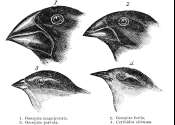
New research shows microevolution can be used to predict how evolution works on much longer timescales
Ever since Charles Darwin published his landmark theory of how species evolve, biologists have been fascinated with the intricate mechanisms that make evolution possible.
Evolution
May 10, 2024
0
886

Genetic study of cauliflower reveals its evolutionary history
A team of plant-breeding specialists at Tianjin Academy of Agricultural Science's State Key Laboratory of Vegetable Biobreeding and other institutions has, via genetic analysis, revealed some of the changes that cauliflower ...

Why evolution often favors small animals and other organisms
Small really does seem to be beautiful in evolutionary terms. The largest dinosaurs, pterosaurs and mammals may look impressive but these giants are vastly outnumbered by microscopic bacteria and single-celled algae and fungi. ...
Evolution
May 10, 2024
0
16

Variability of everyday life may have influenced evolution at least as much as rare activities like big-game hunting
Think about taking a walk: where you need to go, how fast you need to move to get there, and whether you need to bring something along to carry the results of your errand.
Evolution
May 9, 2024
0
8
More news

Chimps shown to learn and improve tool-using skills even as adults

Aggressive wall lizard provides clues to understanding evolution

How evolution has optimized the magnetic sensor in birds
Other news

Scientists develop new geochemical 'fingerprint' to trace contaminants in fertilizer

Furry thieves are running loose in a Maine forest, research shows

Ion irradiation offers promise for 2D material probing

Chemists develop new method for introducing fluorinated components into molecules

Study shows plants restrict use of corrective 'Tipp-Ex proteins'

Major declines reported in South Korean big cat trade

Bacterial proteins shed light on antiviral immunity


















































